| A is for Atwater. Atwater is located near the eastern border of Kandiyohi County. It was incorporated in 1876 and was named after Dr. E.D. Atwater, who worked for the St. Paul and Pacific Railroad. The Atwater Hotel is on the national historic register and has been renovated to house the city offices, police department and library. This photo is from an Atwater High School Homecoming game supporting the Atwater Panthers! These ribbons were donated by Mona Nelson, the Executive Director of the Kandiyohi County Historical Society from 1975-2008. |
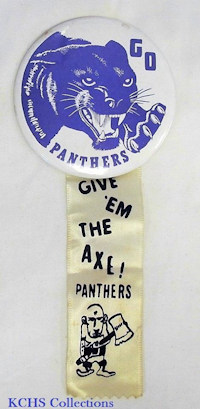 |
| B is for Blomkest. Blomkest is located in the southern part of Kandiyohi County in Roseland Township. Blomkest was established when the Luce Line Railroad came through Kandiyohi County in 1926. Its first name was Kester and then Kesterville, after C.E. Kester of Hutchinson who was a relative of the railroad owner. Ole Blomquist, A.O. Renstrom and Nels Swanson filed a plat with the County for original 12 blocks of the new town. In 1928, when the post office was established is was named Blomkest using the first syllables of Blomquist and Kester. |
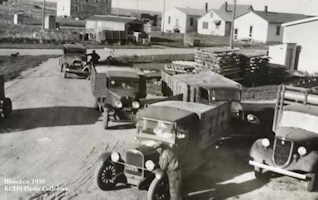 |
| C is for Camping. Kandiyohi County is known for its make lakes, trails and great outdoor recreation. There are many places to camp and explore the great outdoors of our county. We have Sibley State Park and our beautiful county parks: Kandiyohi County Park 3 Games Lake County Park Green Lake County Park Big Kandiyohi County Park West & Big Kandi Park East. It was the lakes and our beautiful land that brought people to this county. Prior to settler contact, the Dakota and Ojibway would come to our county to hunt and fish the land. Camping has been going on in this area for many years. This toaster is used on top of a cook stove to make toast when camping. It was donated by Sadie Miner and is from the 1960s |
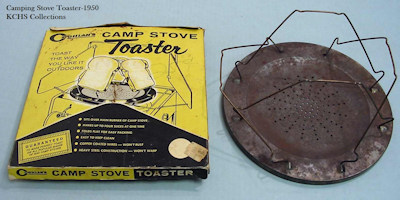 |
| D is for Dutch. During the settlement of Kandiyohi County, there were many Dutch immigrants that settled in the southwestern part of the county in the townships of Holland and Roseland. In 1880, there were 140 Dutch settlers in the County and by 1905 there were 661 settlers. In 1885 two Dutchmen Martin Prins and Theodore Koch offered plots of land in what is now Holland Township. The two men agreed that if 20 Dutch families settled in the area, they would pay for half of the cost of a church. By 1885, 40 purchases were made and Prins and Koch were so pleased that they set aside a 40-acre plot for a village and this became Prinsburg. When the Luce Line Railroad came through in 1927, the second section of the town of Prinsburg came to be near the railroad tracks. So for awhile the town of Prinsburg was two parts. The town of Prinsburg was incorporated in 1952. This plat map is from 1927 and shows the separation of Prinsburg. |
 |
| E is for Endreson. The Guri Endreson Cabin was built in 1858 by Lars and Guri Endreson in Dovre Township in Kandiyohi County. Lars and Guri came to the county in 1857 from Norway with 7 of their children. The cabin was built by Lars Endreson who was a carpenter and that is evident by the structure of the cabin and the dovetailed corners. The Endreson family lived through the U.S. Dakota War of 1862. Two family members were victims of the U.S. Dakota War, Lars and Endre (Guri and Lars's son) are buried at the cabin. Guri Endreson is credited with saving the lives of Oscar Erickson, her son-in-law and Solomon Foot, first settler in Willmar Township by bring them to the Forest City Stockade along with her son, Ole and daughter, Anna. Guri Endreson had a state monument erected in honor of her heroic actions during the U.S Dakota War of 1862 in 1907. The monument is placed at her graveside and is located in the Vikor Cemetery on Solomon Lake. The Guri Endreson Cabin has been a part of the Kandiyohi County Historical Society since 1962. It was listed on the National Register of Historic Places in 1986. |
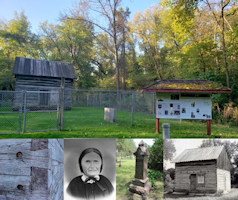 |
| F is for First Street Bridge. The bids for the First Street bridge in City of Willmar, Minnesota were called for in May 1934. In the newspaper article from May 6, 1934, it states that the bridge will cross the Great Northern tracks as an extension of North First Street. It will have three truss spans and will be 980 feet in length. The work began on the bridge in June 1934. One major hiccup to the project happened in October 1934 when the north span of the bridge dropped from its moorings and crashed on top of the freight cars standing on the tracks below. Only one man was injured as it happened in the evening. The north span weighed between 175-200 tons. and damaged six freight cars. The bridge opened in December 1934 with a parade and dedication ceremony. This bridge was a way to formally open a gateway to Kandiyohi County parks and lakes. This bridge was replaced with the current bridge in the early 1990s. At the dedication there was a banner on the south side of the bridge declaring: "Gateway to Minnesota Lakes!" |
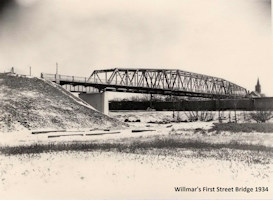 |
| G is for Green Lake. Early settlers called it Carnelian Lake, for the green carnelian stones which were found on the shore. It was later named Green Lake because of the color of the water. Green Lake has always been a huge tourist attraction beginning with the steamboat named the "Belle of Green Lake" offering tours. Green Lake has been home to two villages in the same spot. The first was named Columbia. This town site was staked out August 10, 1856, by J.M. Ayers, V.L. Forsythe and E.T. Woodcock on sections 3 and 4 in Green Lake township and sections 33 and 34 in New London township. This area covered 320 acres including one mile of lake front. Forsythe took a claim adjoining the town site and Woodcock took a claim adjoining the town site on the opposite side. After being surveyed in December 1856, Columbia was incorporated by the Minnesota Territorial Council in 1857. After the U.S. Dakota War of 1862, Columbia ceased to exist. The next village to live in this spot is the City of Spicer. The City of Spicer was plated in 1886 and it is named after John. M. Spicer as he owned the town site. At this time there were two parks established on the shores of Green Lake. The St. Cloud Sioux Falls railroad was built through in this same year. William "Bill" Olson opened the first store in Spicer in 1886. Other businesses opened shortly after this: a lumber yard, elevator, blacksmith, restaurant and feed mill. Tourism has always been an important business to Spicer. The Interlocken Hotel was the first resort in the county opening in 1912 and closed in 1940. The city of Spicer was incorporated in the summer of 1904. |
 |
| H is for Halvorson. Lars Halvorson (1859-1942) Lars Halvorson was a Willmar business man and inventor. He was born on October 3, 1859 in Nes, Hallingdal, Noway. In 1880, he was living in Willmar and according to census he was a shoe maker, jeweler and watch repairman. Lars married Ingeborg Hansdatter on January 7, 1883 and they had nine children. Lars was an inventor and filed for several patents. One was the "Explosive Engine" which the patent was filed on July 9, 1896 and issued on March 8, 1898. He demonstrated his engine at the Minnesota State Fair. Another patent he received was for the "Cuspidor Cleaner" which the patent was issued on July 24, 1906. Lars also built a steamboat that he used on Willmar's Foot Lake. Lars' best known project was the area's first gasoline powered horseless carriage. Lars also formed a company called the Willmar Gasoline Works which he owned until he sold it in 1913. This business was located at 211 Benson Ave in Willmar. Lars died in Willmar in 1942. |
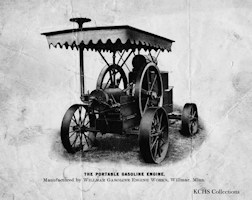 |
| I is for Ice. Ice has been an important part of Kandiyohi County's history. Before refrigerators, the residents and businesses of the county would harvest ice out of the many lakes to use for refrigerating their goods. They would cut blocks of ice out of the lake and haul it to ice houses for storage. The Railroad yards had ice houses to store the ice for the refrigerated cars. Ice harvesting started to decline in the 1940s-1950s when the mechanically operated refrigerators became popular for use. The City of Spicer still uses ice harvesting today. During their Winterfest celebration in the winter, ice is harvested out of Green Lake to build an ice castle. |
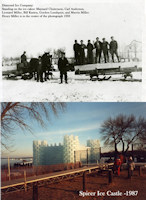 |
| J is for Jericho. Established as a post office in Arctander Township in 1879, Jericho grew, within twenty years, to a settlement of two general stores, (one of which contained the post office), the East Norway Lake Lutheran Church, a creamery, a feed mill, a blacksmith shop, a carpentry and wagon shop and a shoe shop. There were also house for the merchants and shopkeepers. Jericho and Norway Lake settlement are one in the same. This hamlet with its name from Old Testament is to be recorded as one of the landmarks in county history. |
 |
| K is for Kandiyohi. The village of Kandiyohi was first known as Kandiyohi Station. In 1869 the railroad came through this site and James Mattson built the first small store. Kandiyohi Station was the first county seat after the merger of Kandiyohi and Monogalia Couties in 1870. There then ensued the fight for the location of the County seat. It was determined since Willmar was a growing village and near the center of the new county, it would be the county seat. Andrew Railson moved that ahead at the state level. Hutchinson senator, W.T. Bonniwell, secured the votes for Kandiyohi Station. On the day Bonniwell was absent Mr. Railson with the help of A.E. Rice secured the passage by a vote of 16 to 1. The vote for county seat removal to Willmar was 709-538 when it came up for election. The townships whose majority voted against were Roseville, Green Lake, Harrsion, Irving, Kandiyohi, New London. On November 21, 1871 Governor Austin proclaimed the county seat was Willmar. Word came to the county on the 23rd of November and on the 24th, a large and noisy delegation arrived at the “Station” and removed all the county records except the judge of probate and brought back to Willmar. Even after the loss of the county seat, Kandiyohi continued to grow and was incorporated in May 1904. |
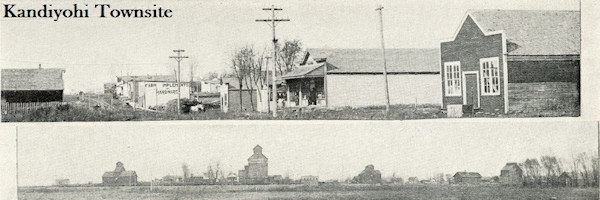 |
| L is for Lake Lillian. Lake Lillian name comes from the lake at the north end of the town. Lillian is name for Edwin Whitefield's wife. Edwin Whitefield was an early explorer of the county that came in 1856. He would paint images of places in Kandiyohi County and sell them to magazines and newspaper back east. These were used as a promotion to get more people to come and settle in this area. The first settlers to the Lake Lillian area came in 1864. The village of Lake Lillian really started to boom in 1923 when the Luce Line Railroad decided to come through the town. The town was incorporated in 1925. In 1926, there was a report of oil being discovered in Lake Lillian by Axel Lundquist, a local restaurant owner. He noticed a liquid seeping into his basement under his place of business. It looked and felt like oil and burned with a clear flame. He then dug a well, actually three wells. He had it tested and it was almost pure gasoline. Lars Erickson who owned the property next to Axel’s dug 2 wells. There was a frantic scramble for oil leases and a drill rig was moved to Lake Lillian in July 1926. The first oil field was on the William Trogen farm, just a mile south of Lake Lillian. There were more attempts made near Prinsburg and Nest Lake. Over 500 people came to visit on a Sunday for curiosity. Unfortunately, this did not become a major industry in Lake Lillian. |
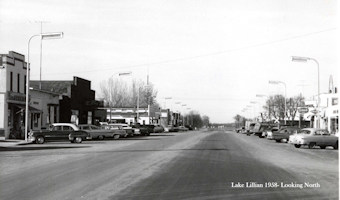 |
| M is for Memorial Auditorium. Today this building is know as the City Auditorium in City of Willmar, Minnesota. When is was first built it's official name was the Willmar War Memorial Auditorium. It was built in 1936 and dedicated in May 23, 1937. The building was built as a WPA (Works Progress Administration) project. The WPA was a depression era federal program that helped get people back into the work force. The auditorium has been used for some many things over the years: auto shows, professional wrestling matches, high school proms and graduations, and many more. One of the more unique rooms in the building is the War Memorial Room. It has a beautiful mural around the room painted by Richard Haines. Another interesting display is the stones from every state that are located on the walls. The stone project was done by the American Legion Post. Watch this Postcards video below to hear from Dale Johnson, the local historian on the War Memorial Room. Currently, the city auditorium has the space for people to rent for activities or meetings, a gun range and a basketball court. It continues to be a community gathering place. |

https://video.pioneer.org/video/postcards-war-memorabilia-veterans-author/?fbclid=IwAR0sq2hXAO8STPaRRgeAQAjm2zeVqNjM_27_ksWDd3xejNaG9DFOfv55WL8
|
| N is New London. New London, Minnesota is the oldest town in Kandiyohi County. It had its pioneer beginnings in 1850, when Louis Larson discovered a waterfall while out on a trapping expedition and visualized a mill. In 1861, he took homestead on a large piece of land, which includes most of present day New London. Larson later named the place for his old home town - New London, Wisconsin. According to the Centennial History of Kandiyohi County, "the discovery of the falls marked the real opening of this area for settlement. Water power, fuel and transportation were the prime needs for the growth of the early settlements." In 1862, the U.S. Dakota War forced an evacuation of the area.. In 1865, many people started to return to the area and went to work. After the work on the dam and the mill were completed, Louis Larson, Charles Sperry, William Wright and Samuel Adams erected a grist mill. Fur-trading helped create a business community and W.W. Pinney opened a general store in 1866, followed by Samuel Adams and A.S. Lybe in 1867. Within a few years, the County seat of Monongalia County was established at New London with offices on the upper floor over Pinney's new store. New London was the county seat until 1870 when the counties of Kandiyohi and Monongalia merged to create the present day Kandiyohi Couhnty. The town mill continued in operation for seventy-three years, growing in size and prospering, and even exporting flour to foreign markets. Then in 1938, the Federal government acquired the mill, the dam and the water rights for a fish hatchery. The mill was removed, but the millpond remains a scenic center for the town. Over the years, other industries have included a creamery, a glove factory, a concrete supply company, a manufacturer of propane gas tanks, and a printing company. New London continued to grow in size and population and became an official city in 1889. |
 |
O is for Opera House. The first opera house was located in the Central Hotel. In 1891 the Central Hotel was erected by William Gilger across from the Great Northern Railroad Depot on 4th and Pacific Ave in the City of Willmar, Minnesota. The opera house was named after William's daughter, Stella. William Gilger had the first brewery in Kandiyohi County located at the current Kandiyohi County Fair grounds. He owned the brewery from 1879-1898. The Stella Opera House opening night was on December 7, 1891. It was built on the location of the Windsor Hotel that had burnt down previously. The building was renamed the Lincoln Hotel and operated by the Osteraas family.
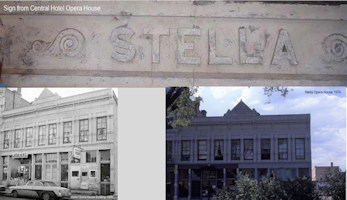
|
P is for Pennock. The railroad station of Pennock was originally called St. Johns, but was changed to Pennock in the fall of 1891. It is named after George Pennock who was the superintendent of the Great Northern Railway in Willmar at that time. The village was incorporated in 1903. In 1891, E.G. Berglund became the postmaster of Pennock. He also opened a hardware store with his brother C.J. Berglund. He was postmaster until his death in 1935. His daughter Emma followed him and became postmaster in 1936 and served as postmasters until 1972. This family served as postmasters in Pennock for 81 years! One of the first murders in the County involved the first saloon keeper of Pennock, Louis Wilson. In late July 1874, Louis Wilson disappeared. The night prior to his disappearance Wilson and a man named Andrew Roos slept in the section house together. The following day Roos came back without Wilson and people began to question where Wilson was and Roos said that he had left for California. Roos then took possession of Wilson's property. On August 13, 1874 August Hans Paulson and friend were hunting at a slough south of Pennock and came upon a human body. The coroner identified the person as Louis Wilson. It was determined he had been murdered and Andrew Roos was arrested. Roos was found guilty and sentenced to prison for life doing hard labor. He was pardoned after 13 years.
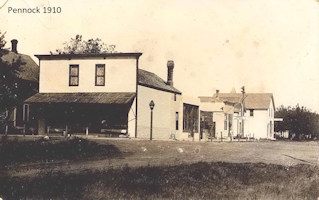
|
Q is for Quale. Judge G. E. Quale's Cabin that is located on the Historical Society's grounds. This building served as a guest cottage and playhouse for children at Judge Quale's lake home on Eagle Lake. The cabin was moved to the Kandiyohi County Historical Society in 1971. This year we will be updating the exhibit inside to tell the story of resorts in Kandiyohi County. Judge Quale bears the most famous name in the judicial circles of the county. For 50 years he was judge of the District Court and he was noted as the senior judge of Minnesota-no other judge has had such a long record. Also he had the record of least reversals of his decisions by the Supreme Court of the state. Quale was born in Norway in 1860 and came to Willmar in 1880. He was largely a self-educated man and a great student in a variety of fields. He was admitted to the bar in 1882 and was associated with Atty. Ludwig Arctander after whom Arctander Township is named. In 1883 Quale became Judge of Probate and in 1890 held the position of County Attorney. He became District Judge in 1897 and served until his retirement in 1946. Judge Quale passed in 1951.
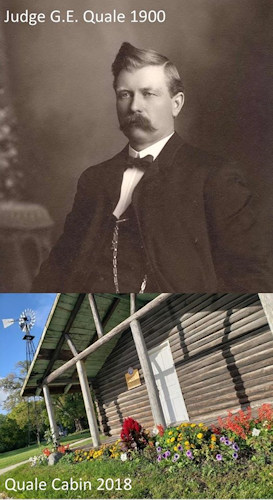
|
R is for Raymond. The town of Raymond was established in 1887 when the Willmar & Sioux Falls Railway laid tracks to the southwest out of Willmar. The name Raymond is in honor of Raymond Spicer, son of John M. Spicer who was the president of the company that built the line. Did you know a person who was born in Raymond invented Cool Whip, Tang and Pop Rocks? William A. Mitchell was born in Raymond October 21, 1911 to William and Florence Mitchell. By 1920, his family had moved to Colorado. William Mitchell worked as a chemist for General Foods Corp. in White Plains, N.Y., for 35 years until his retirement in 1976. He held more than 70 patents, including inventions related to Cool Whip, quick-set Jell-O gelatin and the drink mix Tang. William Mitchell’s most famous invention was Pop Rocks, the exploding candy that became a cultural phenomenon after 1975 when it hit the market. He made the discovery accidentally while trying to design an instant soft drink. He put sugar flavoring mixed with carbon dioxide in his mouth. He passed away on July 26, 2004 in California. He married Ruth Cobbrey and they had seven children.

|
S is for Sunburg. Sunburg started as a post office in 1872 at the home of Ole Eliason. The name of the village was given by Jon Sandvigen, a rural mail carrier. Sund means straits in Norwegian. The post office recommended it to be Sunburg. Sunburg had the pleasure of hosting the kickoff for the 1918 Republican campaign. All the candidates for state office for the Republican party were there. State Senator P.A. Gandrud convinced the party that his hometown of Sunburg was the perfect place to start the 1918 campaign. U.S. Senator Knute Nelson was the keynote speaker for the day inside of a huge tent. It is reported that hundreds of people came to Sunburg that day to enjoy the campaign kick-off.
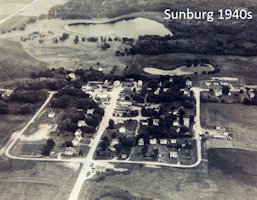
|
T is for Turkey! Kandiyohi County has a rich history with the turkey. Here are some fun facts provided by Minnesota Turkey. If you want to learn more about the turkey business, check out their website at www.minnesotaturkey.com.
🦃 Kandiyohi County is the number 1 turkey producing county in the state of Minnesota.
🦃 Kandiyohi County ranks number 5 in top ten turkey producing counties in the United States.
🦃 Willmar is the home of Farmers Produce Company which is now Jennie-O Foods.
🦃 Willmar is the home of Willmar Poultry and Egg Company which is now Life-Science Innovations.
🦃 Life Science Innovations consists of seven affiliated companies that work with all aspects of turkey production.
🦃 Jennie-O is the 2nd largest turkey processing company in the United States.
🦃 Select Genetics, an affiliate of Life Science Innovations, is the world’s largest turkey hatchery company.
🦃 Minnesota is ranked number 1 for turkey production
.
|
U is for Unusual Item. Does anyone else have an 8 foot coffee pot? Well the Kandiyohi County Historical Society does! The coffee pot first appeared during Willmar's town celebration Kaffe Fest parade. For over 40 years, Willmar would celebrate "Kaffe Fest" every summer. During a survey by the Willmar Tribune in the 1940s, it was found that coffee consumption in Willmar was in the "astronomical" figures. This, and an organization called the Willmar Saucer Drinking Society started the first Kaffe Fest in 1946. It was reported that 15,000 to 20,000 cups of coffee were served during the three-day event in 1946. The word "Kaffe" is not a typo, rather is the Swedish spelling for coffee. Kaffe Fest changed to Willmar Fests in the 1980s. This pot had been missing in action until 2018 when it was found via a Facebook post! The owner donated it to the Kandiyohi County Historical Society and we are working on restoring it for all to enjoy! We would like to thank Chappell Central, Inc. for their generous donation of time and materials to get the coffee pot back in good shape. Currently, Hanson Silo Company is in the process of powder coating it white! It is getting closer to coming to the Historical Society for its final stop. This year is the 75th anniversary of the first Kaffe Fest and it is fitting that the coffee pot has found its way back to Willmar! We are asking for donations to help with the cost of this process! We would like to raise $1000. Please consider making a donation for the restoration of the Kaffe Fest coffee pot!
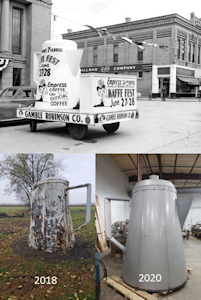
|
V is for Veteran’s Conservation Corps. In 1935 the National Park Service assigned a Veteran’s Conservation Camp No. 1785 to develop Sibley State Park. Sibley State Park was established in 1919 in northern Kandiyohi County. In 2019 Sibley State Park had a 100th year anniversary celebration to honor the opening of the park. The Veteran’s Conservation Corps was a part of the Civil Conservation Corps. The Civil Conservation Corps was voluntary public work relief program that ran from 1933-1942 for unemployed and unmarried men. The Veteran’s Conservation Corps was established in May 1933 for 25,000 World War I veterans to join with no age or marriage restrictions. They were sent to special camps. One of those camps was at Sibley State Park. Up to 200 men worked in the park developing picnic grounds, foot trails, campgrounds, beach house and wells for drinking water. The VCC project at the park ended in 1938.
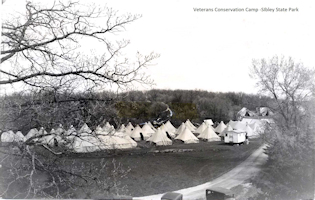 |
W is for Willmar. The railroad came through Willmar in 1869 and the railroad platted out the town of Willmar in 1870. The town is named after Leon Willmar, a businessman from Belgium who worked for the railroad at this time. It became the county seat of Kandiyohi County in 1871 after a contentious battle with Kandiyohi Station. It has been a long time railroad hub since the beginning. The town was incorporated in 1874. One of the more well-known happenings in Willmar is the Bank Robbery that happened on July 15, 1930. Five armed gunmen robbed the Bank of Willmar, located at the intersection of 5th St. and Litchfield Ave, and go away with $70,000 bonds, cash and gold. The five gunman were Harvey Bailey, Tommy Holden, Robert Steinhardt “Frisco Dutch”, Joseph Cretzer “Dutch Joe”, Sammie Silverman “Jew Sammie” and George “Machine Gun” Kelly. After the alarm rang out, gun fire ensued. Two robbers and three bystanders were shot that day, Robert Steinhardt died from his wound. These men were never caught and never tried for the bank robbery. At the time of the robbery, George Kelly did not have his nickname of “Machine Gun” yet, it came two years after the Willmar robbery when his wife gave him a tommy gun as a gift. Check out the article below for more information on the robbery.
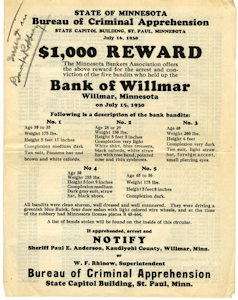
|
X is for X marks the spot. We are going to change it up a little bit today and do a description of this and see if you can figure it out. Good Luck!
This began in 1888. It later moved to the known location in 1892 near railroad tracks. The product made here was shipped all over west central Minnesota, South Dakota and North Dakota. Numbers in the production are 600,000; 60,000; and 15,000 per year. There was more than one item made here. Ownership has changed hands many times. This landmark is the only thing remaining of this location.
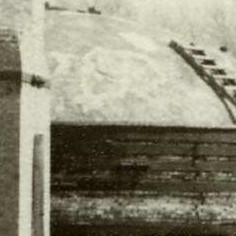
|
Y is for whY. Why was the northern half of the county called Monongalia County? The name was brought here by some of the first settlers of the county. This group of settlers came from Virginia is 1857 and established the town site of Irving on the north-eastern shore of Green Lake. This group had a different name for Green Lake, they called it Carnelian for the reddish pebbles of silica found on the shores of the lake. This group of settlers were successful in getting the state legislature of 1858 to designate the county as Monongalia and Irving town as the county seat. In 1861, the county seat was moved to Columbia and then in 1866 it was moved again to New London. The group of settlers who came from Virginia where form Monongalia County, West Virginia. The name Monongalia is Unami word Monongahela which means “falling banks”. The Unami is the Algonquian language spoken by the Lenape people from the late 17th century and early 18th century. The Lenape or Delaware Nation are people indigenous to the North Eastern Woodlands of New Jersey, Pennsylvania, New York and Canada.
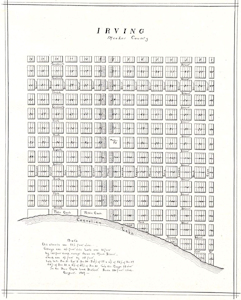
|
Z is for Zimmerman Cabins. As travel by automobile increased, overnight accommodations were needed for families and business men. In 1932 Mr. Henry Zimmerman built eight separate cabins at the intersection of Willmar Avenue and 1st Street. Along with the cabins a full service Phillips Gas Station was located on the site. The distinctive white clapboard and red trim cabins were furnished with beds, a basic kitchen and outdoor bathroom facilities. These cabins were located where right across from Walt’s and Walgreens on First Street in City of Willmar, Minnesota.
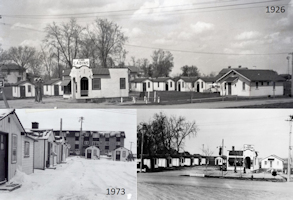
|
| |
| |